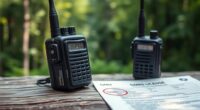Getting confident with cash on hand and ATMs means understanding different cash types, organizing your money, and knowing how to use ATMs safely. Always carry the right denominations, keep small bills handy, and handle cash discreetly. Before withdrawing, check your account balance and withdraw only what you need. If issues pop up, stay calm and follow troubleshooting tips. Keep learning these tips, and you’ll master cash handling and ATM use with ease.
Key Takeaways
- Understand different cash types, denominations, and organization tips to handle daily transactions confidently.
- Follow secure ATM procedures, including PIN protection, transaction verification, and troubleshooting common issues.
- Monitor account balances and transaction history to prevent declines and overdraft fees effectively.
- Carry appropriate cash denominations and plan currency exchange ahead for smoother international transactions.
- Protect your financial information by recognizing phishing scams and staying updated on ATM and online security practices.
Understanding Different Types of Cash and Currency

Cash and currency come in various forms, each serving different needs and functions. Coins are divided into different denominations, like pennies, nickels, dimes, and quarters, making small transactions easy and precise. Paper bills or banknotes come in larger denominations, useful for bigger purchases. When traveling internationally, you might need to contemplate currency exchange to get local money in the right form. Understanding coin denominations helps you quickly identify the value of coins, avoiding confusion during transactions. Recognizing the different types of cash ensures you’re prepared for various situations, whether handling small purchases or exchanging money abroad. Familiarizing yourself with these distinctions, including the types of cash, will help you navigate daily transactions confidently and efficiently.
How to Prepare Cash for Daily Use

To make certain you’re always ready for everyday transactions, it’s essential to organize your cash efficiently. Start by setting aside a dedicated wallet or pouch with your daily cash, including small bills for tips or minor expenses. Practice good cash etiquette by handling bills carefully and keeping small change organized. Incorporate emergency cash planning by carrying a reserve amount separate from your daily funds—just in case. Regularly check your cash supply to ensure you have enough for routine purchases and unexpected needs. Avoid overloading your wallet with unnecessary cash, which can be cumbersome and increase loss risk. Additionally, understanding the horsepower of electric dirt bikes can help you better plan for recreational expenses or transportation needs involving electric bikes. By staying mindful of cash etiquette and planning ahead for emergencies, you’ll handle your daily cash smoothly and confidently.
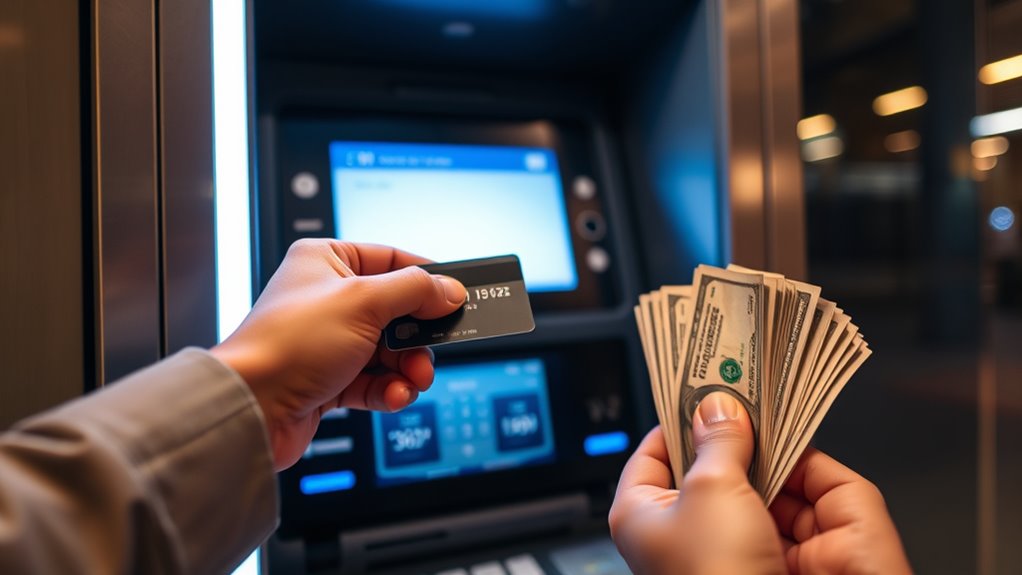
Using ATMs efficiently starts with understanding how to operate them confidently. First, insert your card and enter your PIN securely. Be aware of ATM withdrawal limits, which vary by bank and account type; plan your withdrawals accordingly. When taking cash, select the amount you need, but remember some ATMs have maximum limits. If you’re abroad, currency exchange procedures may be involved, often including fees or rates different from banks. Always verify your transaction before confirming, and keep your receipt for records. If the machine offers currency exchange, follow prompts carefully to select your desired currency and amount. When finished, guarantee you take your card and cash promptly. Familiarity with these basic operations helps you avoid delays and manage your cash effectively. Additionally, understanding projector technology can enhance your home theater experience by ensuring clear and vibrant visuals during your viewing sessions.
Ensuring Your Transactions Are Safe and Secure
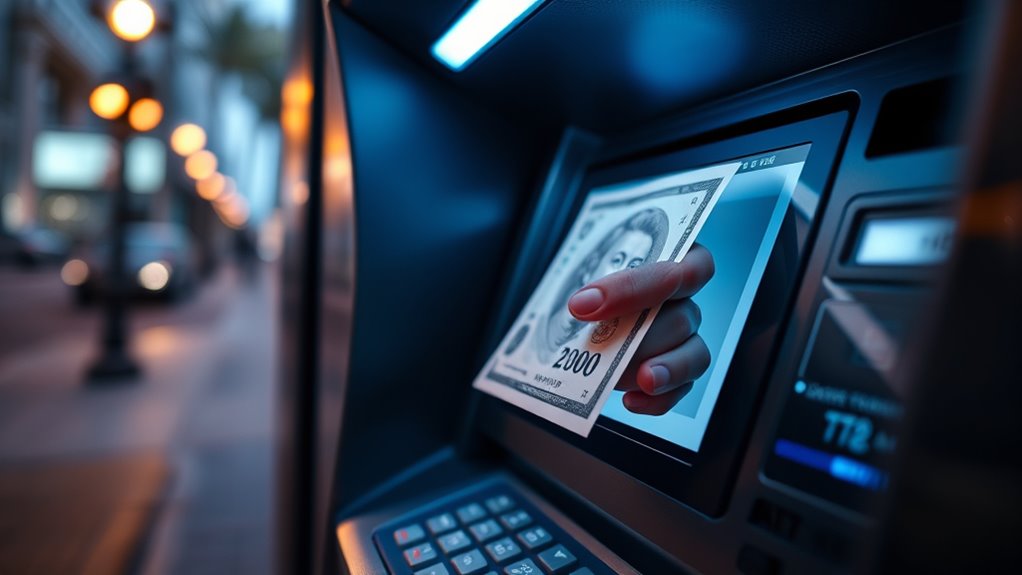
To keep your transactions safe, always protect your PIN and never share it with others. Be cautious of phishing attempts that try to steal your information through fake emails or messages. Staying alert helps you spot threats before they can cause any harm. Remember, understanding privacy and website policies can help you better manage your online security.
Protect Your PIN
Protecting your PIN is essential to keep your transactions safe and secure. Your PIN security directly impacts your ability to prevent fraud and unauthorized access. To safeguard your PIN, always shield the keypad when entering your code, and never share it with anyone. Be cautious about where you store your PIN—avoid writing it down or keeping it with your card. Regularly change your PIN to reduce the risk of it being compromised. Additionally, monitor your account activity frequently for suspicious transactions. Using complex, unique PINs instead of easily guessable ones can further enhance your security. Be vigilant at ATMs, ensuring no one observes your PIN entry. Reporting lost or stolen cards immediately helps prevent misuse. Remember that air quality can affect your overall well-being, so maintaining a healthy environment is also important.
Recognize Phishing Attempts
Being vigilant about phishing attempts is key to keeping your transactions safe and secure. Phishing scams often come through email fraud, where scammers impersonate trusted sources to steal your personal information. Always scrutinize emails that request sensitive data or urge immediate action. Check the sender’s address carefully—fraudulent emails often contain misspellings or unusual domain names. Beware of messages that create a sense of urgency or threaten account suspension. Never click on suspicious links or download attachments from unknown sources. Remember, legitimate institutions rarely ask for confidential details via email. Additionally, understanding the regulatory environment in private placement markets can help you recognize legitimate communication from authorized entities. By staying alert and verifying the authenticity of messages, you can prevent falling victim to phishing scams and protect your financial information from compromise.
Managing and Tracking Your Cash Expenses
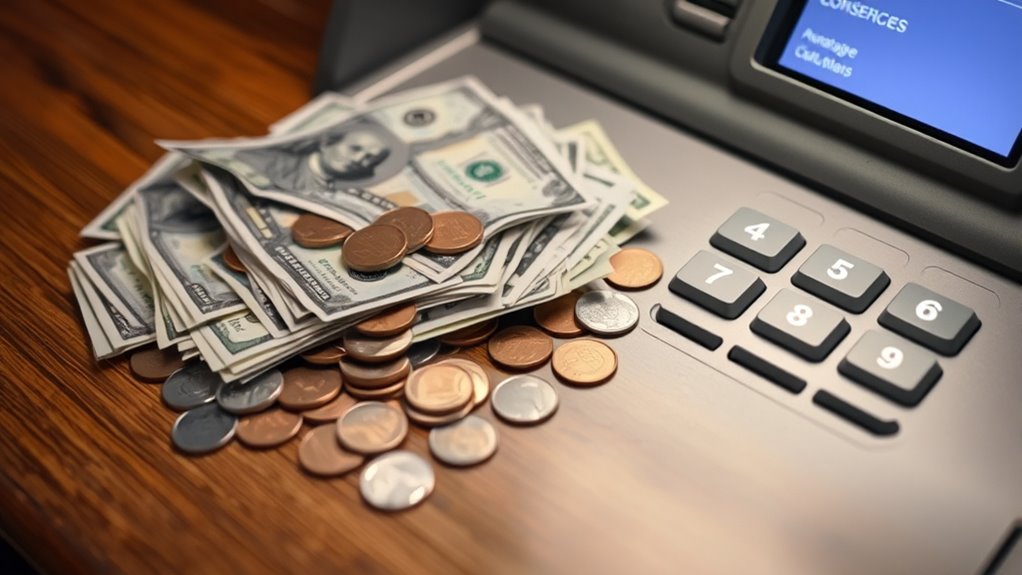
Managing and tracking your cash expenses is essential for staying within your budget and avoiding unnecessary overspending. Proper cash management and expense tracking help you understand where your money goes and prevent surprises at the end of the month. To improve your approach, consider these strategies:
- Keep a daily record of cash transactions to monitor spending habits.
- Use a dedicated envelope system for different expense categories.
- Regularly review your expense logs to identify patterns and adjust accordingly.
- Set spending limits for each category to maintain control over your cash flow.
- Incorporating expense tracking tools can further streamline your management process.
Troubleshooting Common ATM Issues
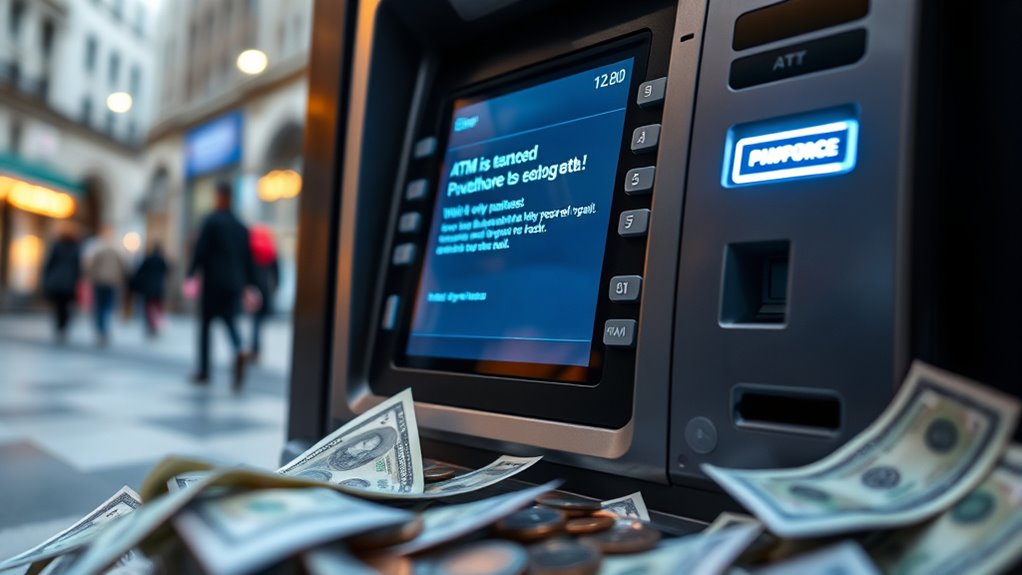
If your card gets stuck in the ATM, don’t panic—simply follow the instructions on the machine to eject it safely. Before trying again, check your account balance to guarantee you have enough funds for the transaction. Addressing these common issues quickly can save you time and prevent further complications. Remember, understanding how city dynamics influence your banking experience can help you navigate unexpected ATM situations more effectively.
Card Jam Solutions
When your card gets stuck in an ATM, it can be frustrating and inconvenient. Knowing how to handle a card jam is essential for effective ATM troubleshooting. First, remain calm and follow the ATM’s instructions, if available. If your card is still stuck, don’t force it, as this may cause damage. Instead, consider these solutions:
- Contact your bank’s customer service immediately for assistance.
- Look for an emergency button or contact information on the ATM for quick support.
- Check if nearby ATMs have posted instructions for card jams.
- If possible, notify the bank about the issue to prevent unauthorized transactions.
- Being aware of common ATM issues can help you respond more effectively during emergencies.
Being prepared with these steps can save you time and reduce stress during ATM troubleshooting, ensuring your card jam gets resolved smoothly.
Insufficient Funds Checks
Encountering an ATM error related to insufficient funds can be confusing, especially if you’ve already tried to withdraw cash after a jam. If your account lacks enough money, the ATM will decline the transaction, preventing you from accessing funds. Keep in mind that some banks allow overdraft protection, which may result in overdraft fees if you’re over your limit. To avoid surprises, check your account balance before withdrawing cash. If you see a decline, review your recent transactions, and consider transferring funds or waiting until your account is replenished. Understanding your bank’s policies on insufficient funds and overdraft fees helps prevent unexpected charges. Always monitor your account to ensure you have enough cash on hand and avoid unnecessary ATM errors. Being aware of European cloud innovation can also help you stay informed about new financial technology solutions that enhance security and efficiency.
Tips for Handling Cash in Different Situations

Handling cash effectively in different situations requires awareness and preparation. Being mindful of cash etiquette helps you navigate social and professional settings smoothly. When dealing with currency exchange, always count your money carefully and verify the rates beforehand. To stay confident, consider these tips:
- Carry a variety of denominations to handle diverse transactions.
- Use discreet handling to respect others’ cash etiquette.
- Keep smaller bills for tips and casual payments.
- Plan ahead for currency exchange when traveling abroad to avoid unnecessary fees.
Frequently Asked Questions
How Can I Identify Counterfeit Cash Easily?
You can identify counterfeit cash easily by performing simple counterfeit detection techniques. Check for cash authenticity by feeling the texture—genuine bills have a distinct feel due to the special paper. Examine security features like watermarks, security threads, and color-shifting ink under different angles. Use a UV light or a counterfeit detection pen if needed. These steps help verify your cash is real and protect you from accepting fake bills.
What Should I Do if My ATM Card Is Swallowed?
When your ATM card is swallowed, stay calm and act quickly to guarantee ATM safety. Contact your bank immediately to report the issue and request a card replacement. Meanwhile, use another ATM or branch to access your funds if needed. Your bank will guide you through the process to resolve the situation smoothly, helping you regain access and keep your finances secure.
Are There Fees for Using ATMS Abroad?
Yes, there are often fees for using ATMs abroad, especially for foreign transactions. When you make an ATM deposit or withdraw cash internationally, your bank may charge a foreign transaction fee and a surcharge from the ATM operator. To avoid surprises, check your bank’s policy before traveling, and consider using ATMs within your bank’s network abroad to minimize extra costs.
How Can I Set up Alerts for Cash Withdrawals?
Setting up alerts for cash withdrawals is like having a security guard watching your back. You can typically do this through your bank’s app or online banking. Just navigate to ATM security or transaction alerts, then set your preferred cash withdrawal limits. These alerts help you stay on top of your ATM activity, ensuring you’re notified of any withdrawals that exceed your limits, keeping your account safe and secure.
What Are the Best Practices for Storing Large Amounts of Cash Securely?
To securely store large amounts of cash, you should invest in a high-quality safe or secure lockbox designed for cash handling. Keep the cash in a discreet location, away from prying eyes, and limit access to trusted individuals. Regularly audit and document your cash holdings to prevent theft or loss. Using secure storage practices minimizes risks and guarantees your cash remains safe and protected at all times.
Conclusion
Now that you know the basics, boldly bank, balance, and banknote with confidence. By mastering methods, managing money, and troubleshooting troubles, you’ll become a cash-conscious champ. Keep your cash clear, your cards secure, and your confidence climbing. Remember, every encounter with currency and ATMs is an opportunity to improve, inspire, and increase your financial finesse. Stay savvy, stay secure, and step confidently into your cash-conscious future!

